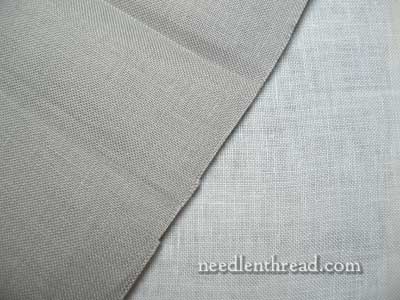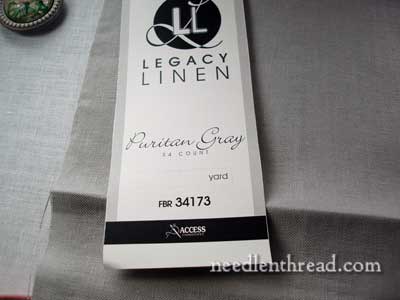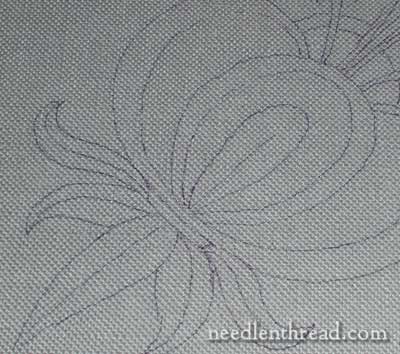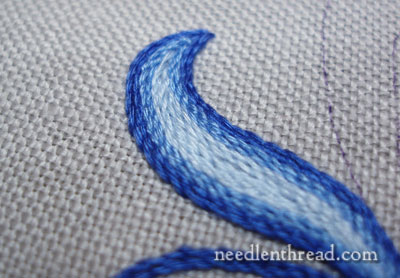Have you ever tried to characterize yourself by color? Me, neither. But if I did, gray wouldn’t exactly come to mind. Reds would. Blues might. But gray? Not really. Granted, it isn’t really a “color” proper – it’s just a shade – but normally, I’m not too attracted to grayness.
However, the first time I smacked eyes on Legacy’s “Puritan Gray” linen for hand embroidery, I new I had to use it for something. I liked it. I liked the putty grayness of it, and I really liked the way it felt.
In my head, “contrast” was bubbling up. The idea of contrast, that is – whites on gray, blues on gray, maybe flaming reds on gray. I didn’t know yet, but I did have, floating around in my head, the notion that whatever is stitched on the gray (as long as it’s not more gray) would somehow jump out in contrast to the gray. I’m not sure if this makes sense, but it’s something I’m dabbling with.

The photo above isn’t exactly an eye-catcher, I suppose. But I wanted to show you the color of Puritan Gray by Legacy. I’d also like turn your computer into one of those tactile books for children, where you can actually feel the stuff. But since that’s out of the question….

Puritan Gray is a 34 count linen made by Legacy and made available in the US through Access Commodities. Yes, it’s an even-weave, but it’s a high enough count that, with the right thread, it works great as a ground fabric for surface work. It has a Wonderful Hand. Hand, when you’re talking about fabric, is the feel of the fabric, and it usually refers to the fabric’s surface and other tactile characteristics – so, smoothness or roughness, weightiness, suppleness …. all the things that go together to produce the tactile sensation when you come in contact with the stuff. In this case, Puritan Gray is smooth, substantial feeling, but not heavy (though not too light). It’s kind of a medium weight linen, with good body. The gray is a putty gray. It’s not a chalk gray – it almost has a hint of pinkish puttiness to it, without looking pink.
Putty. But not silly putty.

It’s light enough that, with a good light table, you can make a decent tracing, though admittedly, it isn’t super easy to trace on it. I plan to play around with some transfer ideas before settling on tracing as an absolute. Or I may actually invest in a better light table. The little plastic thing I’ve been using for years kind of stinks.

I’m “playing” with a design right now, in shades of blue. It’s a beautiful blue, and there are four shades of it available in floche. And I like them together. And I like them on the gray. If these shades of blue can be had in silk, I might try silk, but I kind of like the idea of working a whole project in floche. We’ll see. Then there’s the background. And there’s that idea of subtle white laciness that keeps coming to mind. But more on that one later!
So what do you think? Blues on gray? Reds on gray? Skip the gray? No, no! I think you’d like the gray! It’s surprisingly appealing! Ok, but really, scratch the gray? White on gray? (White looks lovely and elegant on the gray, by the way!) Well, right now, I’m playing with it. And I’ll show you more with the gray, the more I play!
Enjoy your day!







Hi There,
Try shades of pink with the gray it also looks stunning
Regards
The blue looks great. The colours look really bright on the grey, is tnat usual?
But I’m thinking white, that would look really classy.
I love gray and white together, and another color that looks great with gray is pink. I saw a pink, white and gray quilt one time that was absolutely beautiful. Very soothing tones of color, restful, pretty.
I also like the strong colors on the gray, such as the blues you showed, but pink and white would be right for certain designs. You’ll know it when you see it 🙂
The word Puritan gray brings to mind the Pilgrim Settlers – the only fabric they had access to was flax which always came out a sort of putty grey colour like this. The yarn colors they produced were dependant on vegetable and plant dyes such as Indigo, muddy red, sludgy green, etc so if you looked more closely into these shades you would probably get it right.
Just had to give my two pence worth!
I like the blues on the gray. I think reds, leaning toward the orangey reds, would be dynamite.
Hi Mary–your blue on gray is lovely. I love stitching on gray. It’s a good neutral color that almost everyone else looks good on. And that Puritan Gray is a nice one, plus your description of its weight makes it seem worth having. I think I’ll have to go order me some.
Carol S.
I love this color of gray as a foundation fabric. I recently experimented with using white #8 Perle Cotton doing some sampler stitch practicing, and particularly liked the look of the border done in open fly stitch. If you are thinking “lacy” maybe a #3 Perle cotton would give you that effect?
Try gold. I’m thinking gold color threads (742 perle cotton with some shine) but also goldwork on gray. It’s stunning. I like red and gray, too. Gray is one of my favorite background colors. I’ll have to get some of this linen.
I love gray. I don’t know why. But I’m always attracted to it–in clothing, interiors, dogs…
What a lovely fiber to play with. I think I’ll have to add this to my holiday wish list!
I, too, like the blue on gray. I am SO in the mood to do some embroidery…..as soon as I finish my knitting projects!
Love it…
There’s a reason that that particular shade of gray works with pretty much everything–it’s very close to the ‘gray card’ used by photographers to ‘true’ the color in their shots. It’s extremely neutral, and most all colors except its own will show up quite well.
Enjoy–and don’t forget the gold and silver. 🙂
flaming orange on grey. Brick red on grey. Dusty rose and old gold, or maroon and old gold on grey.
I *love* grey. Your Puritan Grey is a touch lighter than my favourite shade – I like a nice pewter shade to really bring out the colour, and then anything you put on it will really sing.
I really like the blue/gray combination… red with gray will be beautiful but I’m being a bit bias since I’m a red girl…(red car, red wallet, etc..).
Now white on gray lovely… the only thing is how will you play with dif. shades and still keep it white/gray ?
Oh Mary, I can’t help myself. Grey is one of my favourite colours and grey and black is the best combination of all. So if it were my project, it would be all shades of grey (warm given the warmth of the cloth colour) with black for oomph! and some silver goldwork-type threads for sparkle. I have to confess, and no offence to others, that the idea of gold on grey does not appeal. But as the French say, chaqu’un a son gout.
I love the grey and blue, looks good. I have a grey skirt that I was thinking of embroidering a border with white and black and a dash of red/orange. Maybe I’ll change my mind now.
Your comment “Yes, it’s an even-weave, but it’s a high enough count that, with the right thread, it works great as a ground fabric for surface work.” has sent me into a spin.
For surface work, surely evenweave would be preferred? Or, since it’s surface work, it wouldn’t matter whether it is, or isn’t?
*collapses in welter of confusion*
Hi, All! Thanks for your comments and input about the gray. I love it, too! I’m going to be playing quite a bit with it, to see what I can come up with as far as design / color / thread choices. But playtime is postponed until I get through a heap of school work! Once that’s over, I have Plans!
Megan – even weave is ok for surface work, under certain conditions. The higher the count, the easier it is to do surface embroidery on it. Lower count fabrics are more difficult to work on, if using fine threads, but you can always line the linen with muslin to help support the surface stitches, which does help when working with the lower counts with finer threads. Take, for example, satin stitch. It’s difficult to achieve a smooth edge on satin stitch when working on, say, a 25 or 28 count linen, using a strand of regular floss, or even a strand of floche or coton a broder. The weave of the fabric is too “open” to get a real nice edge. But if you line the fabric with muslin, then you have the muslin behind the linen to hold the closely worked stitches. Hope that makes sense!
Have a terrific weekend, everyone!
Hi Mary, What is “the right thread” for this fabric that you mentioned? It looks beautiful and I would like to try using it myself but I’m not sure what you meant by the right thread for surface work on this fabric.
Hi, Susie – Pretty much any thread will work on this, I think. It’s a high enough count linen that it will hold even finer threads. Just make sure you use a crewel or “embroidery” needle rather than a tapestry needle. They have sharper points than tapestry needles, and will split the fabric threads, which is what you want when working surface stitches…
~MC
Thanks, Mary! 🙂